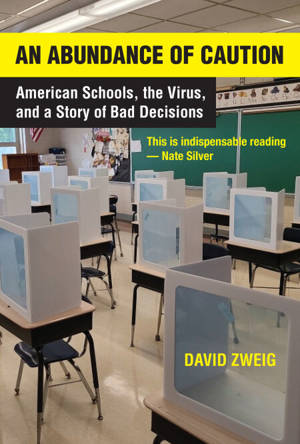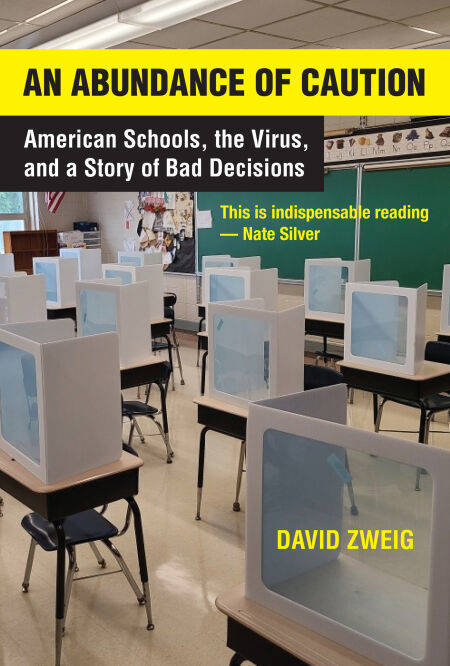
Bedankt voor het vertrouwen het afgelopen jaar! Om jou te bedanken bieden we GRATIS verzending (in België) aan op alles gedurende de hele maand januari.
- Afhalen na 1 uur in een winkel met voorraad
- In januari gratis thuislevering in België
- Ruim aanbod met 7 miljoen producten
Bedankt voor het vertrouwen het afgelopen jaar! Om jou te bedanken bieden we GRATIS verzending (in België) aan op alles gedurende de hele maand januari.
- Afhalen na 1 uur in een winkel met voorraad
- In januari gratis thuislevering in België
- Ruim aanbod met 7 miljoen producten
Zoeken
An Abundance of Caution E-BOOK
American Schools, the Virus, and a Story of Bad Decisions
David Zweig
E-book | Engels
€ 39,38
+ 39 punten
Uitvoering
Omschrijving
A searing indictment of the American public health, media, and political establishments’ decision-making process behind pandemic school closures.
An Abundance of Caution is a devastating account of the decision-making process behind one of the worst American policy failures in a century—the extended closures of public schools during the pandemic. In fascinating and meticulously reported detail, David Zweig shows how some of the most trusted members of society—from Pulitzer Prize–winning journalists to eminent health officials—repeatedly made fundamental errors in their assessment and presentation of evidence. As a result, for the first time in modern American history, millions of healthy children did not set foot in a classroom for more than a year.
Since the spring of 2020, many students in Europe had been learning in person. Even peers at home—in private schools, and public schools in mostly “red” states and districts—were in class full time from fall 2020 onward. Whatever inequities that existed among American children before the pandemic, the selective school closures exacerbated them, disproportionately affecting the underprivileged. Deep mental, physical, and academic harms—among them, depression, anxiety, abuse, obesity, plummeting test scores, and rising drop-out rates—were endured for no discernible benefit. As Europe had shown very early, after they had sent kids back to class, there was never any evidence that long-term school closures, nor a host of interventions imposed on students when they were in classrooms, would reduce overall cases or deaths in any meaningful way.
The story of American schools during the pandemic serves as a prism through which to approach fundamental questions about why and how individuals, bureaucracies, governments, and societies act as they do in times of crisis and uncertainty. Ultimately, this book is not about COVID; it’s about a country ill-equipped to act sensibly under duress.
An Abundance of Caution is a devastating account of the decision-making process behind one of the worst American policy failures in a century—the extended closures of public schools during the pandemic. In fascinating and meticulously reported detail, David Zweig shows how some of the most trusted members of society—from Pulitzer Prize–winning journalists to eminent health officials—repeatedly made fundamental errors in their assessment and presentation of evidence. As a result, for the first time in modern American history, millions of healthy children did not set foot in a classroom for more than a year.
Since the spring of 2020, many students in Europe had been learning in person. Even peers at home—in private schools, and public schools in mostly “red” states and districts—were in class full time from fall 2020 onward. Whatever inequities that existed among American children before the pandemic, the selective school closures exacerbated them, disproportionately affecting the underprivileged. Deep mental, physical, and academic harms—among them, depression, anxiety, abuse, obesity, plummeting test scores, and rising drop-out rates—were endured for no discernible benefit. As Europe had shown very early, after they had sent kids back to class, there was never any evidence that long-term school closures, nor a host of interventions imposed on students when they were in classrooms, would reduce overall cases or deaths in any meaningful way.
The story of American schools during the pandemic serves as a prism through which to approach fundamental questions about why and how individuals, bureaucracies, governments, and societies act as they do in times of crisis and uncertainty. Ultimately, this book is not about COVID; it’s about a country ill-equipped to act sensibly under duress.
Specificaties
Betrokkenen
- Auteur(s):
- Uitgeverij:
Inhoud
- Aantal bladzijden:
- 464
- Taal:
- Engels
Eigenschappen
- Productcode (EAN):
- 9780262380034
- Verschijningsdatum:
- 21/04/2025
- Uitvoering:
- E-book
- Beveiligd met:
- Adobe DRM
- Formaat:
- ePub

Alleen bij Standaard Boekhandel
+ 39 punten op je klantenkaart van Standaard Boekhandel
Beoordelingen
We publiceren alleen reviews die voldoen aan de voorwaarden voor reviews. Bekijk onze voorwaarden voor reviews.









